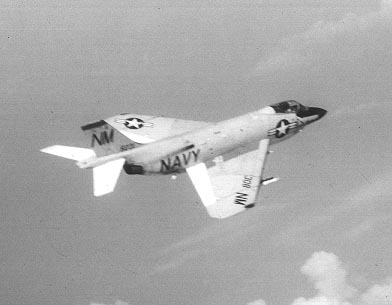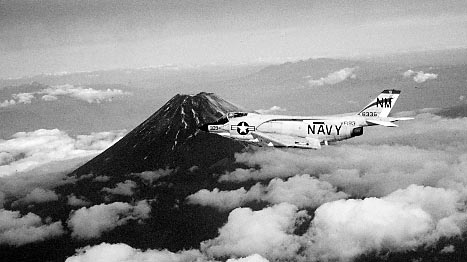The
F3H-2
THE GOOD, THE BAD AND THE UGLY
Because of the unreliability and the lack of
performance of the J-40 the Navy was forced to look for another engine - and not many were
available. The J-57, one of the best engines at the time, was tied up in production for
the Air Force F-100 and the Navy F8U.
The J-71 was the only realistic alternative engine. Substituting engines required
redesigning the ducts, but only so much could be done without redesigning the entire
aircraft, which was not acceptable. The fact that the J-71 was shoehorned into an aircraft
not designed to accept it was the source of continuing problems, and the engine never
produced the thrust required to make the Demon the "high-performance" aircraft
originally promised.
The first flight of a J-71 F3H-2 occurred in late October 1954. Navy J-71 evaluations were
completed in 1955 .
In 1956 the Navy ordered 239 F3H-2 Demons; these, in addition to the 30 Demons designed
for the J-40 that were modified to accept the J-71, brought the total buy of J-71 powered
F-3H's to 269. The Demon's operational career lasted some eight and one half years, from
March 1956 until September 1964 when VF-161 retired its last Demon.
Although the Demon was the Navy's first true all-weather missile fighter, and its' front
line all-weather interceptor from 1957, until it was replaced by the F-4 Phantom in 1962,
it is remembered by very few. Because of it's developmental problems it was an aircraft
that those responsible in NAVAIR and McDonnell Douglas would just as soon forget.
The cockpit was roomy and comfortable. Changes made to the canopy/nose design following
tests of the initial prototype, provided good visibility for the pilot during landing.
The Demon's great weapons system - the combination of the APG-51 radar and the Sparrow
missile, gave the F3H a true all weather capability. The radar had a detection range of
about 40 miles, and could lock on targets up to 20 miles. Map modes went out to 200 miles.
In afterburner the Demon had excellent performance. It's optimal climb speed in
afterburner approached Mach 1
The Demon was a very stable, sturdy aircraft - with excellent landing characteristics.

To correct the aircraft/engine interface
problems Allison shaved the tips of the compressor blades and installed bleeds that closed
when the RPM exceeded 91.5%, and opened below 91.5%. The thrust jumped upward when the
bleeds closed and sharply decreased when they were open. Speed brakes were extended during
landing approaches to minimize engine operation in the unstable power range during landing
approaches.
The Demon was the first fighter to have hydraulically operated control surfaces, without
mechanical back-up. In case of hydraulic failure, a ram air hydraulic pump popped out from
the belly of the aircraft, just forward of the the belly of the aircraft, just forward of
the lower engine access bay, driving a hydraulic pump that powered the small
emergency-only hydraulic system. In early Demons the scheme worked fine as long as the
aircraft was at higher speeds, but in the landing pattern the small propeller didn't
provide enough energy to support the hydraulic needs for aircraft control.
In case of hydraulic failure the engine nozzles would fail in the open position. With the
afterburner nozzles open there would not be enough thrust at military power to safely land
the aircraft. To correct this deficiency, provision was made for the engine afterburner to
operate throughout the entire engine RPM range - from military to idle. Even with the
J-71, the Demon was still underpowered. For instance, on a hot day at Albuquerque AFB,
according to the takeoff distance calculator, the runway length necessary for takeoff, at
military power, was infinity, a bit longer than the 15,000 feet available.

The production ejection seats, which failed to function properly, caused a number of
fatalities. These seats were replaced by Martin Baker seats, with much improved
reliability and performance
Early production F3H 's had a tendency to flame-out when flying in rain or icing
conditions. The problem was corrected by adding engine bleeds and by shortening some
compressor blades, which further reduced the thrust from the makeshift J71, which was
adapted from the engine used in the Air Force's B-66 bomber (the Air Force's version of
the Navy A3D).
Although the Demon was the Navy's first true all-weather missile fighter, and its' front
line all-weather interceptor from 1957, until it was replaced by the F-4 Phantom in 1962,
it is remembered by very few. Because of it's developmental problems it was an aircraft
that those responsible in NAVAIR and McDonnell Douglas would just as soon forget .
Next Page...
First page...
© 2005 by Bob Jellison
Wednesday, March 23, 2005
www.carrierbuilders.net |

